水原华城
水原华城(:)或华城(:)是韩国京畿道水原市中央的一座堡壘。[1][2]這個朝鮮堡壘由朝鮮王朝正祖從1794年到1796年建成,以紀念他的父親莊獻世子。莊獻世子在不遵守他的父親英祖自殺命令的情況下,被英祖命人關進米櫃內活活餓死。華城位於首爾以南的30(19英里),圍繞水原中央的大部分地區,堡壘包括金正王宮宮殿。1997年經联合国教科文组织列为世界文化遺產。水原川是水原主要河川,會流經山城的中央。
| 水原华城 | |
| 諺文 | |
|---|---|
| 汉字 | |
| 文观部式 | |
| 马-赖式 | |
| 维基共享资源中相關的多媒體資源:水原华城(分類) |
| 世界遗产 | |
|---|---|
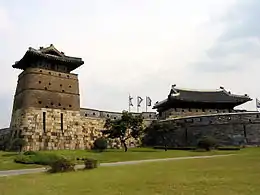 华城古堡 | |
| 官方名稱 | (英文) (法文) |
| 位置 | |
| 標準 | 文 ii, iii [1] |
| 登录年份 | 1997年(第21屆大會) |
| 網站 | UNESCO的记录(英文) |
建造
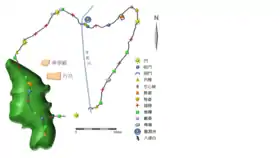
水原華城建築工程根據建築師丁若鏞設計而進行,由1794年至1796年以兩年半時間建成,丁若鏞是一名實學運動的著名領導者。實學指實踐學習,鼓勵科學和工業的使用,正祖將當時韓國和中國的堡壘設計以及當代科學融入建造華城的計劃之中。而使用磚作為華城的主要建築材料以及投入丁氏設計的西洋式高效滑輪和起重機也是由於當時實學對朝鮮的影響。[3]
華城的建設也是作為萬曆朝鮮之役期間朝鮮前線崩潰的一種回應。當時在韓國建築堡壘的主導模式是為城市或城鎮作為一個簡單的防禦作用,華城還有一個單獨的山地堡壘,人民在戰爭時期可以安全撤離到此地。然而,這個山城被建造成包括牆壁,防禦堡壘和市中心的元素,四個主要門被用作城鎮出入口的門。沿著城牆建成的突出型弩台,雉樓和砲樓,具有籬笆的欄杆和城垛,是堡壘的重要防禦性元素,而牆壁也是抵檔攻擊的要點。
華城總共耗資七十萬人力,為當時的成本八十萬七千兩,還有支付1500袋大米給工人。過去政府的重大基建是以徭役方式進行,但在這種情況下,工人的工資是由政府直接支付的,另一個原因實學影響的標誌。
仁祖顯然建起了這座堡壘,準備將首都從漢城遷往水原。水原被視為漢城與西海(黃海)和中國的戰略地位。國王想要對朝鮮王朝不正之風進行改革,相信水原有潛力成為朝鮮王朝新的繁榮首都。為了鼓勵水原的建設,他以一大筆特別政策去獎勵人們以搬到水原,例如水原居民免稅十年。而仁祖還下令建設教育設施等公共工程,以更好地促進水原成為國家首都,也籍此拱衛首都漢城。
華城建築記錄
在正祖去世一段時間後,一張名為《華城城役儀軌》(韓語:)的白紙在1800年被公開。在韓戰期間,由於華城遭到嚴重破壞,在1970年開始進行十多年的的重建工程。這些數量按華城各部分劃分,首先涵蓋「華城城役儀軌」建築計劃,包括藍圖和監事名單。接下來「華城城役儀軌」的六卷詳細說明了建築物的實際執行情況,如皇室和工人工資記錄。最後三卷是補充部分,詳細說明了毗鄰宮殿的建設。當時建設華城的人力由專業人員進行分配,按行業分工,將其分類為工頭,石匠,勞工等等。「華城城役儀軌」還詳細記錄並說明了不同材料的使用量。[4]
法文版由法國駐韓國領事亨利·查華利亞(Henry Chevalier)出版,[5]由德文版則參考趙斗元(韓語:/Cho Doo-won)的論文來進行翻譯。[6]
 南暗門
南暗門 東北角樓
東北角樓 南空心墩
南空心墩 南水門
南水門 烽墩
烽墩
主要建筑
- 长安门,华城北门,门楼五间,左右有双阙,门外有瓮城
- 八达门,华城南门
- 苍龙门,华城东门
- 华西门,华城西门
- 华虹门,建于正北的水门
- 访花随柳亭,位于华虹门之东,又名东北阁楼
- 西将台
- 华城行宫,正门为中阳门,正殿为惠庆宫居住的奉寿堂,国王寝宫为洛南轩,还有长乐堂、景龙馆、维与宅、左翊门、右翊门、新丰楼、未老闲亭等建筑。
- 华城乡校
- 大有屯,位于华城西北方的国营农场
- 万石渠,石砌水库
結構介紹
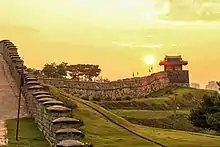
城牆
城牆的長度為5.74公里(3.57英里),長度介乎於4至6米(13-20英尺)之間,最初包圍約1.3平方公里(0.5平方英里)的土地。[7] 在平坦的地形上,建造的城牆通常比通過兩個山丘中的任何一個都高,因為較高的城牆被認為不太需要沿著山頂。護欄由石頭和磚製成,像大多數山城一樣,身高1.2米(4英尺)。所有部件維護良好,整個城牆都可以方便地行走。
4個主要城門
1795年的堡壘有四個門:長安門(北門),華西門(西),八達門(南)和蒼龍門(東)。當中長安門和八達門是四大門之中最大的兩個,它們與漢城南大門的屋頂設計,所選用的石材和木材極為相似。事實上,長安門是韓國最大的城門。北門和南門均設有兩層的木製城楼,華西門和蒼龍門分別位於西門和東門,只有一層。 四個主要的大門都被由守衛人員組成的小型堡壘圍護著。
現今的入口
如今,水原「內城」需要大量居民和遊客所需的現代化道路。這些大型道路是在城牆建成的過程中建成的,1975年的重建工程中只能保留這些道路。對於其中三條步道來說,這些步道已經被重建為兩個相鄰結構之間的橋樑:
- 進入北門的橋樑介乎北門長安門和北東敵臺之間
- 進入東門的橋樑介乎東北弩臺與東北空心墩之間
- 進入西門的橋樑介乎西門華西門與西北空心墩之間。此外,與八達山相關的兩個小地下通道也被保留。它們分別位於西1炮塔和南炮塔附近。
至於最大南入口,已經使用了更為激進的解決方案。四個結構(西南和東南門防守平台,南暗門和南空心墩)根本沒有重建,現在的南門八達門仍然與華城其他部分隔絕,平日被一大堆交通工具所包圍。
其他結構
在水原華城城牆上的所有結構(見下面的描述)中,最引人注目的是
砲樓(포루)與鋪樓(포루)
因為漢字在朝鮮語的發迿會出現同音異義,而砲樓和鋪樓在諺文的發音都是포루,因而產生華城幾個設防結構的命名衝突。根據官方權威文件《華城城役議軌》 (1801年), 為華城不同種類的設防結構取不同的名稱是方便分類。這樣就可以將砲台和鋪樓分類。 以下圖片集展示了這些結構在設計中的差異及作用性:
 東:
東:
東砲樓
동砲樓 東北:
東北:
東北砲樓
북동砲樓 西北:
西北:
西北砲樓
북서砲樓 西:
西:
西砲樓
서砲樓 南:
南:
南砲樓
남砲樓
 東2:
東2:
東二鋪樓
동2鋪樓 東1:
東1:
東一鋪樓
동1鋪樓 東北:
東北:
東北鋪樓
북동鋪樓 北:
北:
北鋪樓
북鋪樓 西:
西:
西鋪樓
서鋪樓
城牆上48個主要結構
沿城牆的48個原始結構(包括已經消失的部分)可以按照其功能進行排序:[8]
- 主要城門 (4): 南、東、北和西
- 水門 (2): 南、北
- 烽墩 (1): 烽墩
- 甬道 (1): 西南甬道 (용도)
- 將臺 (2): 東、西
- 角樓 (4): 東南、東北、西北、西南
- 敵臺 (4): 南東, 北東, 北西, 南西
- 暗門 (5): 南, 東, 北, 西, 西南
- 空心墩(3): 南, 東北, 西北
- 舖樓 (5): 東2, 東1, 東北, 東, 西
- 砲樓 (5): 東, 北東, 北西, 西, 南
- 弩臺 (2): 東北, 西
- 雉樓 (10): 東3, 東2, 東1, 北東, 西1, 西2, 西3, 東南1, 東南2, 南
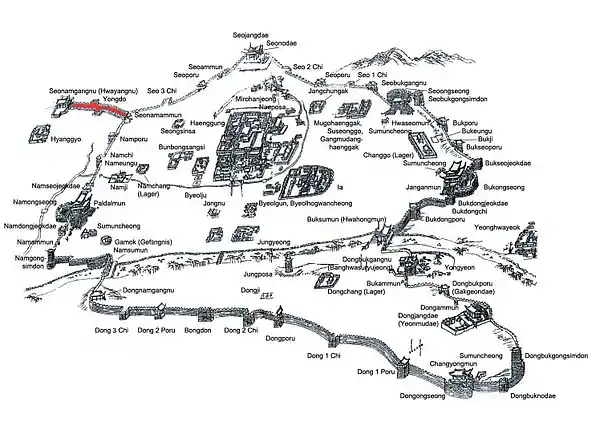
其中四個結構被排除在重建之外。西南和東南門敵臺,南暗門和南空心墩均位於南門(八達門)附近。它們將繼續被清除,以提供遊客和居民所需的現代化道路。
這48個結構也可以如「首爾指南」般按照「城牆」列出,[10] 或「亞洲歷史建築」 .[11] 在這裡,這些結構以南門(使用水原公共交通的接入點)開始以逆時針方向順序列出。
- 南門 (남문)
- 南東敵臺 (남동적대)
- 南暗門 (남암문)
- 南空心墩 (남공심돈)
- 南水門 (남수문)
- 東南角樓 (동남각루)
- 西三雉 (동삼치)
- 東二舖樓 (동이포루)
- 烽墩 (봉돈)
- 東二雉 (동이치)
- 東砲樓 (동포루)
- 東一雉 (동일치)
- 東一舖樓 (동일포루)
- 蒼龍門 (창룡문)
- 東北弩臺 (동북노대)
- 東北空心墩 (동북공심돈)
- 東將臺 (동장대)
- 東暗門 (동암문)
- 東北砲樓 (동북포루)
- 北暗門 (북암문)
- 東北角樓 (동북각루)
- 華虹門 (화홍문)
- 北東砲樓 (북동포루)
- 北東雉 (북동치)
- 北東敵臺 (북동적대)
- 長安門 (장안문)
- 北西敵臺 (북서적대)
- 北西砲樓 (북서포루)
- 北砲樓 (북포루)
- 西北空心墩 (서북공심돈)
- 西門 (서문)
- 西北角樓 (서북각루)
- 西一雉(서일치)
- 西砲樓 (서포루)
- 西二雉 (서이치)
- 西弩臺 (서노대)
- 西將臺 (서장대)
- 西暗門 (서암문)
- 西砲樓 (서포루)
- 西三雉 (서삼치)
- 西南暗門 (서남암문)
- 西南甬道 (용도)
- 甬道西雉 (용도서치)
- 西南角樓 (서남각루)
- 甬道東雉 (용도동치)
- 南砲樓 (남포루)
- 南雉 (남치)
- 南西敵臺 (남서적대)
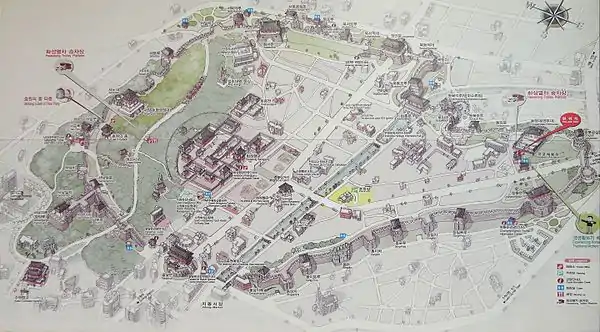
南門 (남문)
37°16′39″N 127°01′01″E
八達門 (韓語:),通常被稱為南門 (韓語:),坐落於水原市中心要道之圓環上。 Its stone base is capped with a two-storey wooden pavilion surrounded by a stone wall. A small, semi-circular protective wall known as an ongseong, is located on the south side (outside) of the gate. The gate also houses a bell called Paldalmun Dongjong, which was originally cast in Gaeseong in 1080 and was refounded in 1687 by Dohwaseung, the chief priest of Manuisa Temple, for use in Buddhist ceremonies. 123 cm tall and 75 cm in diameter, it hangs from a dragon-shaped suspension ring, has a flue pipe to set the tone and has a slightly curved body - features which are typical of Korean bells of that era. This particular bell's flue pipe has a design of the dragon's tail entwined around it and is topped with a lotus flower. The top of the bell has a line of Sanskrit words around it, while the bottom is decorated with arabesque designs. The decorative nipples are interspaced with Bodisattvas holding lotus flowers. The bell is very similar in design to that in Tongdosa, which differs notably from Paldalmun's only in size.[12]
由於在韓戰期間八達門倖免於難,所以沒有經歷與城牆上其他結構的廣泛重建。 因此,一些橫樑已經廣泛下垂,所以自2010年9月開始,八達門正在進行全面拆除,修理和重新組裝門的屋頂。[13]
 看不到交通工具的八達門南面和內城
看不到交通工具的八達門南面和內城 西面的黃昏的
西面的黃昏的 東面的夜晚
東面的夜晚 從東南角樓的屋頂看
從東南角樓的屋頂看
東南敵臺 (남동적대)
華城南北門兩旁都設有敵臺。今天只剩下北門(長安門)得以保留。
 A:八達門; B:西南敵臺 & 東南敵臺; C:東南空心墩; D:南水門
A:八達門; B:西南敵臺 & 東南敵臺; C:東南空心墩; D:南水門
南暗門 (남암문)
此門已經消失。
 儀軌設計圖
儀軌設計圖
南空心墩 (남공심돈)
南空心墩, like that standing by Hwaseomun, was an observation tower standing beside the Suwoncheon. It is part of the section of Hwaseong which has not been restored.
 Uigwe picture
Uigwe picture
南水門 (남수문)
南水門, meaning South Floodgate, sat across the Suwoncheon at the downstream end of the city walls. The gate was a little over a kilometre from Hwahongmun, the gate at the upstream end. Construction began on February 28, 1794, was interrupted, but continued in November 1795, the structure being completed on March 25, 1796, but having been fully operational since completion of its basic structure on January 16 that year. The bridge had nine arches for the water to flow beneath: two more than Hwahongmun because of increase in flow. Above the bridge there was a large brick structure instead of the usual gatehouse, as this section of Hwaseong was one of the most vulnerable. This took up two thirds of the space above the arches, the remaining third being the bridge.
This gate was swept away in a flood in 1846. It was restored but washed away again by a flood in 1922. During the general restoration of the Fortress in 1975, no consensus was obtained on how to rebuild the gate, and the area remained reserved in its ancient status.
The issue arose again during the rehabilitation of the entire Suwon Stream, inside and outside the Fortress, that was initiated in 2006. [14]
Concerning Namsumun, the restoration was launched in June 2010 and the restored floodgate is 29.4m long, 5.9m wide and 9.3m high. The inauguration was 2012-6-9. [15]
 The Suwoncheon at the site of Namsumun (2008)
The Suwoncheon at the site of Namsumun (2008) Uigwe picture
Uigwe picture
東南角樓 (동남각루)
37°16′42″N 127°01′11″E
東南角樓, sits on top of a small rise above the former location of Namsumun. Its location serves its purpose as a lookout tower well, as much of Hwaseong and the area outside to the south and east can been seen from here.
 The north side
The north side Flag flying beside the pavilion reading 巡視.
Flag flying beside the pavilion reading 巡視. The exterior
The exterior At night
At night Uigwe picture
Uigwe picture
東三雉 (동삼치)
37°16′44″N 127°01′13″E
Dongsam Chi, the third eastern turret, lies halfway from the south-east pavilion to the second eastern sentry post. Like other turrets, it extends a short distance perpendicularly from the wall to enable guards to see and attack assailants who had already reached the fortress.
 Looking towards Dongnam Gangnu
Looking towards Dongnam Gangnu The south-east corner
The south-east corner Seen from outside
Seen from outside
東二舖樓 (동이포루)
37°16′49″N 127°01′14″E
Dong-i Poru, the second eastern sentry post, like other sentry posts, is a wooden structure sitting on a turret. Construction of this post was completed on July 3, 1796 and it was intended to defend the beacon tower. For this purpose, it extends further out from the wall than the north-western sentry post. It also lacks wooden front doors.
 The steps
The steps The exterior
The exterior Uigwe picture
Uigwe picture
烽墩 (봉돈)
37°16′53″N 127°01′17″E
烽墩, the beacon tower, sits midway from Paldalmun to Changnyongmun. It is located intentionally in direct line with Haenggung so that the king could see its signals. Smokes and lights were used to signal the state of threats. The southernmost of its five chimneys was used during peacetime.
 North side
North side Seen from Dong-i Chi
Seen from Dong-i Chi Doorway
Doorway From the wall
From the wall Northern chimneys from inside
Northern chimneys from inside Southern chimney from inside
Southern chimney from inside The exterior
The exterior Uigwe picture
Uigwe picture
東二雉 (동이치)
37°16′57″N 127°01′20″E
東二雉, the second eastern turret, like the other nine turrets around Hwaseong, allowed soldiers to look out in many directions along the exterior of the wall. Unlike the other two eastern turrets, the outer corners of this structure are rounded, the others forming sharp right angles.
 The north side
The north side The exterior
The exterior
東砲樓 (동포루)
37°17′01″N 127°01′23″E
東砲樓, the eastern GunTower, lies between the two eastern turrets. Construction of the post was completed on July 16, 1796. As with other GunTowers in Hwaseong, the interior is of multiple levels to allow various angles for firearms and other weapons.
 The entrance
The entrance Seen from Dong-i Chi
Seen from Dong-i Chi Seen through a hole in Dong-i Chi
Seen through a hole in Dong-i Chi The exterior
The exterior Uigwe picture
Uigwe picture
東一雉 (동일치)
37°17′05″N 127°01′27″E
Dong-il Chi, the first eastern turret, is the first turret south of the first eastern sentry post, lying 148(486英尺) along the wall towards the beacon tower.
 Inside the turret
Inside the turret The exterior
The exterior
東一舖樓 (동일포루)
37°17′09″N 127°01′28″E
Dongil-SentryPost, the first eastern sentry post, was completed on July 10, 1796. Like the second eastern sentry post, it extends further from the wall than most posts.
 Looking south from the post
Looking south from the post The exterior
The exterior Uigwe picture
Uigwe picture
東門 (동문)
37°17′16″N 127°01′31″E
蒼龍門 (창룡문), 通常被稱為東門 (동문),它位處在一個主要的路口。它的石頭基座上蓋著數層木製的亭子。朝鮮戰爭期間東門被摧毀,及後在1975年進行重建。
 西面
西面 西面的夜景
西面的夜景 南面
南面 東面
東面 從內部觀看角度
從內部觀看角度 從內部觀看角度
從內部觀看角度
東北弩臺 (동북노대)
37°17′20″N 127°01′31″E
Dongbuk Nodae is one of two crossbow platforms in the fortress and is situated within reach of the east gate and has a wide field of view as it sits on a corner of the wall, enabling archers to target assailants from many angles.
 Inside face seen from the south
Inside face seen from the south The north corner of the outside face
The north corner of the outside face Dongbuk Nodae and Dongbuk Gongsimdon seen from outside the walls
Dongbuk Nodae and Dongbuk Gongsimdon seen from outside the walls Uigwe picture
Uigwe picture
東北空心墩 (동북공심돈)
37°17′22″N 127°01′28″E
東北空心墩,意指東北瞭望臺,位於蒼龍門對面。外表呈橢圓形,樓高 6.8(22英尺),三層。可沿著旋轉形樓梯直達天臺。
 從東面展望
從東面展望 從西南面展望
從西南面展望 西南方夜景
西南方夜景 西南方夜景近觀
西南方夜景近觀 從城牆展望
從城牆展望 從窗外望向旋轉形樓梯
從窗外望向旋轉形樓梯 儀軌圖
儀軌圖
東將臺 (동장대)
37°17′18″N 127°01′23″E
Dongjangdae, meaning eastern command post, stands next to Dongbuk Gongsimdon, facing Changnyongmun across an archery field. When the king was in residence in Haenggung, within the fortress walls, there were two generals and four soldiers on guard in this command post at all times. (There were five night shifts.) Each officer was armed with a bow and arrow, sword and baton. The command post is nicknamed Yeonmudae, a reference to its second function as a training camp.
 The southern side
The southern side Nighttime view of the southern side
Nighttime view of the southern side The eastern side
The eastern side Annexe just below the main building
Annexe just below the main building Gateway on the western side
Gateway on the western side
東暗門 (동암문)
37°17′14″N 127°01′17″E
東暗門,為東端暗門, 位於東將臺 140(459英尺)之上 , was used for passage of people, animals and munitions. Construction of the gate, which sits beneath a brick structure surmounted with a large round parapet, was completed on March 25, 1796.
 Outside face
Outside face Outside face seen from the north-east
Outside face seen from the north-east Door seen from outside
Door seen from outside Inside face
Inside face Interior seen from the west
Interior seen from the west The interior seen from the wall to the west
The interior seen from the wall to the west The exterior seen from the wall to the west
The exterior seen from the wall to the west Uigwe picture
Uigwe picture
北暗門 (북암문)
37°17′14″N 127°01′07″E
北暗門(韓語:),官方稱為第3北暗門(韓語:)是三個原結構中唯一剩下的暗門。它靠近東北角樓。
 暗門和東北角樓
暗門和東北角樓 從城牆上看到的北暗門
從城牆上看到的北暗門 外部
外部 內部
內部 儀軌圖
儀軌圖
東北角樓 (동북각루)
37°17′15″N 127°01′06″E
The north-east pavilion is known as Dongbuk Gangnu and nicknamed Banghwasuryujeong. It sits above Yongyeon, a pond surrounded by a small garden. It was originally intended to be the second battle command post, though its scenic location made it a place favoured instead for feasts.
 Daytime view
Daytime view Nighttime view
Nighttime view Seen from the Suwoncheon
Seen from the Suwoncheon Closeup
Closeup Seen from Yongyeon
Seen from Yongyeon Outflow from Yongyeon a few metres downstream from Hwahongmun
Outflow from Yongyeon a few metres downstream from Hwahongmun Level view
Level view Closeup of wall
Closeup of wall Uigwe picture
Uigwe picture
華虹門 (화홍문)
37°17′15″N 127°01′04″E
Hwahongmun, otherwise known as Buksumun, is the gate under which the Suwoncheon flows on entering the area encompassed by Hwaseong and exited through Namsumun. The gate has the obvious function of being a bridge, but also housed cannons for defensive purposes. The Suwoncheon was widened at this point and the gate has seven arches through which it passes.
 The north side
The north side From the path beside the Suwoncheon (upstream)
From the path beside the Suwoncheon (upstream) The north side in snow
The north side in snow View downstream
View downstream The south side in snow
The south side in snow Uigwe picture
Uigwe picture
北東砲樓 (북동포루)
37°17′19″N 127°01′00″E
Bukdong-GunTower sits between Janganmun and Hwahongmun. This tower controls the North-East outskirts of the Fortress, and protects Hwahongmun. It was completed on September 23, 1794. Not to be confused with 동북포루, the East-North SentryPost.
 From the west
From the west The west side
The west side Uigwe picture
Uigwe picture
北東敵臺 (북동적대)
37°17′21″N 127°00′53″E
Bukdong Jeokdae is a platform immediately to the east of Janganmun. It housed a cannon to protect the gate and its ongseong.
 See from the west in snow
See from the west in snow Outside
Outside
長安門 (장안문)
37°17′20″N 127°00′51″E
長安門 (韓語:),通常被稱為北門 (韓語:),為南韓最大城門。亦有部分人稱之全球最大, as it is through this gate that visitors from Seoul will have entered Suwon and this would be in keeping with King Jeongjo's original desire to move the capital of the country to Suwon. Janganmun's stone base is capped with a two-storey wooden pavilion. A small, semi-circular protective wall known as an ongseong, is located outside the gate. The gate was destroyed in the Korean War and reconstructed in the 1970s.
 Nighttime view of the interior face
Nighttime view of the interior face Nighttime view of the roof
Nighttime view of the roof Seen from Bukseo Jeokdae
Seen from Bukseo Jeokdae Seen from Bukseo Jeokdae in snow
Seen from Bukseo Jeokdae in snow The ongseong
The ongseong View from inside Janganmun
View from inside Janganmun
北西敵臺 (북서적대)
37°17′19″N 127°00′49″E
Bukseo Jeokdae is a platform immediately to the west of Janganmun. It housed a cannon to protect the gate and its ongseong.
 The west side
The west side
北西砲樓 (북서포루)
37°17′14″N 127°00′44″E
Bukseo-GunTower is adjacent to Bukseo Jeokdae. Made from black bricks, it is divided into three storeys internally by boards. Firearms were secreted on these floors. The roof is unusual in design, being gabled on the inner side (towards the wall) and angled to the outer side (away from the wall). Construction was completed on September 24, 1794.
 The west side
The west side The south side
The south side The roof
The roof The exterior
The exterior Uigwe picture
Uigwe picture
北砲樓 (북포루)
37°17′14″N 127°00′44″E
Buk-SentryPost is another Sentry Post containing hidden firearms. This is closer to Hwaseomun than to Janganmun. Today a tourist information centre and public toilet stand on the north side of the structure. Construction was completed on February 20, 1795.
 The west side
The west side The east side
The east side Seen from outside
Seen from outside Uigwe picture
Uigwe picture
西北空心墩 (서북공심돈)
37°17′09″N 127°00′34″E
Seobuk Gongsimdon is an observation tower standing directly adjacent to Hwaseomun, giving it the obvious function of being a lookout post to protect the gate. Built from bricks on three sides, its inside is partitioned into three storeys with two wooden floors, from which soldiers could fire cannons and other firearms. It is said that, in 1797, on visiting Suwon, King Jeongjo claimed to his companions that this was the first gongsimdon in Korea. Its construction was completed on March 10, 1796.
 From outside Hwaseomun in snow
From outside Hwaseomun in snow From the wall
From the wall Hwaseomun and the tower
Hwaseomun and the tower From the south-west
From the south-west Uigwe picture
Uigwe picture
西門 (서문)
37°17′08″N 127°00′35″E
華西門 (韓語:)是華城的西門。它的石頭基座上蓋著一層層的木製亭子。
 從外面看雪地的城牆
從外面看雪地的城牆 華西門、北門砲樓、北舖樓和長安門
華西門、北門砲樓、北舖樓和長安門 夜景
夜景 南面觀看西門
南面觀看西門 內部的雪景
內部的雪景 內部的雪景
內部的雪景 內部
內部
西北角樓 (서북각루)
37°17′04″N 127°00′30″E
Seobuk Gangnu, facing a hill known as Sukjisan, is the lookout post immediately anti-clockwise from Hwaseomun. With less of a wide field of view than from the other side of the gate, it is shorter than the gongsimdon a short distance to the north-east. The pavilion's ground floor is fitted with an under-floor heating system.
 The west side
The west side A corner of the pavilion
A corner of the pavilion Seen from outside the walls in snow
Seen from outside the walls in snow Seen from outside
Seen from outside View from Seobuk Gangnu
View from Seobuk Gangnu The interior
The interior Uigwe picture
Uigwe picture
西一雉 (서일치)
37°17′02″N 127°00′29″E
Seo-il Chi, meaning West Turret 1, is a small bulge in the wall to allow soldiers to fire upon anyone attempting to scale Hwaseong from the outside.
 The south side
The south side The turret and Seobuk Gangnu
The turret and Seobuk Gangnu The interior
The interior Seobuk Gangnu (left) and Seoil Chi (right)
Seobuk Gangnu (left) and Seoil Chi (right)
西砲樓 (서포루)
37°16′57″N 127°00′31″E
Seo-GunTower sits partway up the hill named Paldalsan when heading anti-clockwise from Hwaseomun to Seojangdae. It controls the outskirts of Mount Paldal, and protects the Western Command Post (seojangdae). It was completed on May 30, 1796, and was one of Hwaseong's most heavily armed posts.
This structure shall not be confused with the Seo-SentryPost.
 The south side
The south side The exterior
The exterior The exterior
The exterior Uigwe picture
Uigwe picture
西二雉 (서이치)
37°16′54″N 127°00′34″E
Seo-i Chi, the second turret on the west of Hwaseong, stands just below Seonodae on the slopes of Paldalsan. Its purpose, as with any turret, was to provide a location to attack people trying to scale the walls.
 The south side
The south side The interior
The interior The Exterior
The Exterior
西弩臺 (서노대)
37°16′51″N 127°00′36″E
Seonodae is an octagonal, steep-stepped, black brick platform directly adjacent to Seojangdae at the crest of Paldalsan when heading uphill from Hwaseomun. From here, archers could attack assailants in a wide range of directions and facing downhill, too.
 Seen from the front
Seen from the front Seen from the side
Seen from the side Original piece of wall by Seonodae
Original piece of wall by Seonodae Uigwe picture
Uigwe picture
西將臺 (서장대)
37°16′51″N 127°00′36″E
Seojangdae, meaning western command post, sits atop Paldalsan, a small hill over which the higher section of Hwaseong runs. Seojangdae was destroyed by a fire in 1996 and was reconstructed afterwards. However, on May 1, 2006, an arsonist attacked Seojangdae. The arsonist reportedly caused the fire by lighting his clothes and underwear with a cigarette lighter. The fire caused about ₩6 billion in damage (about $6 million), destroying the upper floor of the watchtower. Seojangdae was reconstructed in 2007.
 Nighttime view
Nighttime view Daytime view
Daytime view View from Seonodae
View from Seonodae
西暗門 (서암문)
37°16′49″N 127°00′36″E
Seoammun, the West Secret Gate, lies 50(164英尺) south of Seojangdae. Sitting on a forested part of the ridge of the hill Paldalsan, it was designed to provide access in and out under cover. Today, it is easily accessible from the road outside, being located near Jindallae (Azalea) Public Toilets.
 Interior side
Interior side The outside
The outside Closeup of door
Closeup of door Uigwe picture
Uigwe picture
西舖樓 (서포루)
37°16′45″N 127°00′35″E
Seo-SentryPost sits on a turret projecting from the wall 140(459英尺). It controls and protects the West Secret Gate that sits immediately southwards. The structure was completed on August 18, 1796.
This structure shall not be confused with the Seo-GunTower, which sits on the other side of Seojangdae.
 The south side
The south side Steps
Steps Panelling
Panelling
西三雉 (서삼치)
37°16′39″N 127°00′39″E
Seosam Chi, the third western turret, has the same function as the other nine turrets around Hwaseong. It sits just north of the south-western spur.
 The south side
The south side The entrance
The entrance The interior
The interior Seen from outside
Seen from outside
西南暗門 (서남암문)
37°16′38″N 127°00′42″E
Seonam Ammun is the beginning of a path to Seonam Gangnu, the south-western pavilion. The gate used to contain a house known as a posa, and Seonam Posa, the south-western posa, sat above the gate, enabling soldiers to keep watch and issue alerts.
 Seen from the spur (Original wall visible)
Seen from the spur (Original wall visible) The upper section
The upper section Seen from Yongdo
Seen from Yongdo Seen from outside
Seen from outside Uigwe picture
Uigwe picture
西南甬道 (용도)
37°16′35″N 127°00′43″E
為了控制沿著八達山的山脊,華城堡壘有一個甬道。它始於山頂的西南暗門,經過八達山的西南端,最後到達西南角樓,又名華陽樓(韓語:)。如今這個位置提供了飽覽水原市的大景觀,包括水原站。
 西南角樓最高點
西南角樓最高點 由西南角樓看東北
由西南角樓看東北 西南角樓東北方向
西南角樓東北方向 西南角樓內部
西南角樓內部
甬道西雉 (용도서치)
37°16′34″N 127°00′44″E
兩個雉樓位於西南暗門到西南角樓方向的中間。它在暗門右側,西南一雉(서남일치)延伸至華城西部,俯瞰著水原市向西湖方湖。它也被稱為勇道西雉(용도서치)。
 西雉樓的勇道
西雉樓的勇道
西南角樓 (서남각루)
37°16′32″N 127°00′44″E
西南角樓(韓語:),華陽樓(韓語:),位於西南暗門的尖端,可以看到許多水原建築,包括水原站。
 從南面
從南面 甬道盡頭的西南角
甬道盡頭的西南角 地面
地面 儀軌圖
儀軌圖
甬道東雉 (용도동치)
37°16′35″N 127°00′44″E
這兩個雉樓位於西南暗門的西南方向到西南角樓的中間。即在西南角樓的右邊,西南二稚(서남이치)一直往東延伸,俯瞰著南部八達門的城牆(現在八達山上已經變得樹木茂盛了,但現在看不到)。它通常被稱為甬道東雉 (용도동치)。
 甬道東雉
甬道東雉
南西敵臺 (남서적대)
當時南北門兩旁都是守衛臺。今天,只剩下北門守衛臺保留下來。
1795年8日大巡行
正祖因父親莊獻世子墓園—永祐園風水不佳,且在墓穴中有蛇,因此將其從楊州拜峰山遷移至水原華山腳下,並更名為顯隆園。原位於華山腳下的水原郡官衙及村莊奉命一同搬遷至八達山腳下。而每年都為正祖都會組織一次皇室巡行,敬拜他父親的墳墓。1795年二月的皇家巡行最大型的一次,適逢正祖母親獻敬王后六十歲生辰,同時也是其已故父親誕辰六十週年。(請緊記,在韓國的出生日是算1歲,所以韓國人的60歲生日是指61歲)。在1795年的巡行是一個巨大的事件,動員共5,661人和1,417匹馬。[16]
像往常一樣,這個庭園事件也被皇家圖書館記錄下來,根據《園幸乙卯整理儀軌》(韓語:)(乙卯= 1795年)。每一個儀軌,本文件的幾個「正式副本」已經被確認(正本更為珍貴,為國王使用而保留)。 該儀軌的主要文件是八屏: 華城行幸圖 屛風(화성행행도 병풍)如今,這個屏風存在三個副本中,其中一個是棕褐色的,[17]另是一個藍色(見下面的畫廊)和一個彩色,[17][18] 而朝鮮國王使用的副本。最後一份可以在三星藝術博物館看到,並在2005-04-15被指定為國寶1430號。[19]
這些畫作描繪了巡行的重要事件,儘管畫廊小組的順序並不反映巡行實際的程序。[20]
- 在華城的聖廟進行祭祀, 1795年2月11日
- 文武考試, 1795年2月11日
- 在奉壽堂為正祖母親舉行六十生辰宴會, 1795年2月13日
- 洛南軒的養老宴, 1795年2月14日
- 在守將臺的夜間軍事演習, 1795年2月12日
- 世祖在得中亭進行射箭活動, 1795年2月14日
- 巡行期間回到行宮, 1795年2月15日
- 在鷺梁津巡行期間穿越漢江上的一座浮橋, 1795年2月16日
在奉壽堂舉行的宴會,像當時的傳統繪畫類似。然而,描繪返回行宮的巡行的場景的組成形式是「之」的形狀,這是著名的法院畫家金弘道的終身畫作的特徵。畫廊最後一幕描繪了巡行隊伍橫渡在漢江一座浮橋上展現出獨特的作品,這在當時在皇室巡行畫中很少見到類似場景。[19]
根據皇室記錄,正祖的母親獻敬王后對於如此宏偉的規模和驚人精確度的屏風感到非常高興,她獎勵了七位參與其中的畫家。分別是崔得賢(韓語:)、金得臣(韓語:)、李命奎(韓語:),張漢宗(韓語:)(1768 - 1815),尹碩根(韓語:),許寔(韓語:)(1762 - ?)和李寅文(韓語:)。

화성성묘전배
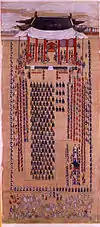
낙남헌방방
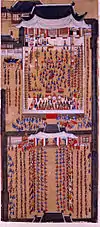
봉수당진찬
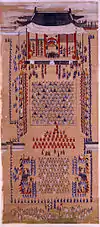
낙남헌양로연
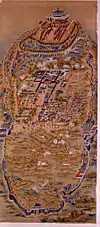
서장대야조
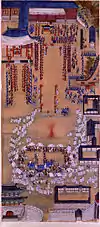
득중정어사
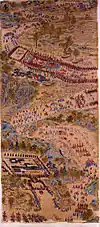
환어행렬
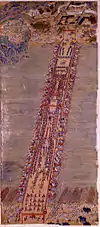
한강주교환어
這些小組和山城的軍事圖之間的比較很有趣:庭園畫家的重點似乎更多地針對文官(例如: 龍淵在何處?以及如何通過北暗門(북암문)到達這個池塘?)。而不是關注軍事(例如東將臺在圖中消失了)。其中一個原因被認為是出於某種軍事「機密」的考慮。

화성전도
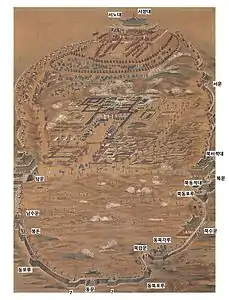
화성행행도 병풍(5)
重建和維修
水原華城主要的重建工作是在1970年代進行,雖然在之後經過都定期維護。 在下列表中概括了各項重建的成本(韓圓₩)(來自京畿道的數據)。[21]
| 日期 | 區域 | 結構 | 週圍 | 總計 |
|---|---|---|---|---|
| 1975年1月 | 長安門-西將台 | 281,144,000 | 11,770,000 | |
| 1975年2月 | 西將台-八達門 | 192,024,000 | 4,190,000 | |
| 1976年 | 北水門-蒼龍門 | 289,150,000 | 137,650,000 | |
| 1977年 | 長安門-北水門 | 46,944,000 | 133,900,000 | |
| 1978年 | 蒼龍門-甬道 | 148,088,000 | 234,690,000 | |
| 總共 | 957,350,000 | 522,200,000 | 1,479,550,000 | |
- 直至2008年冬天水原市議會正在對城牆進行維護,而南門的屋頂正在進行徹底的拆除和重建。 [13]
- 直至2011年3月,東北空心燉開始進行維護工程
- 南水門的全面維護工作在2010年6月展開,實際閘長29.4米,寬5.9米,高9.3米。重開典禮是2012年6月9日。[15]
 西將台的維護工程
西將台的維護工程 南鋪樓的維護工程
南鋪樓的維護工程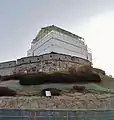 東北空心燉維護工程
東北空心燉維護工程
節日和表演
水原華城有幾個值得觀看的表演和節日。大部分表演在行宮前面的廣場進行,如下。
週末表演
在三月至十一月的每個星期六下午二時舉行各種傳統表演。
武術表演
二十四武術表演是按照正祖國王時代他所採用的慣例而進行的演示。二十四武術表演在1790年由李德木和朴齊家以及武術大家白東秀(韓語:)製作武術教學的教科書,教科書大多內容是由朝鮮王朝的藝術所組成的。這些武術是由華城的士兵在壯勇營(장용엉)的監督下所練習的。示範活動由3月至11月11日(星期一除外)每天早上11時,而12月僅在星期六和星期日舉行。
皇家衛隊儀式
這個儀式是在重建十九世紀九十年代在華城的皇家衛隊儀式,由被提拔為「訓練守衛」(韓語:)的皇室衛兵。當時在韓國最大的軍營中有一萬二千人守衛。當正祖國王於1789年將他父親的遺體搬到水原時,他命名為顯隆園(韓語:),並派兵從這個營中守衛新園址。1793年將水原城的名稱從水原地改為華城,在牆內修建了一個附屬於華城的壯勇營(韓語:)。根據華城的官方網站表示,這個表演將從3月到11月每個星期日的下午2點舉行。
虛構描述
水原華城堡壘是韓國電視劇正祖暗殺之謎-8天的拍攝場地。該部電視劇描述1795年正祖為他母親獻敬王后60歲生日所組織的慶典,同時也紀念了他已故父親莊獻世子六十歲生日。[22]
劇本是基於2006年由午世英(오세영)撰寫的小說《遠行[23]》(원행)。劇中除虛構的元素之外,主要參考兩個歷史的來源。恨中錄序列中許多部分被廣泛使用,紀錄在莊獻世子死亡之前(1762年)的閃回部分,而朝鮮皇室圖書館的官方文件則用於1795年的建設華城的活動紀錄文件:《園幸乙卯整理儀軌》(원행을묘뎡니의궤)以及關於華城整體的《華城城役儀軌》(화성성역의궤)[24][25]。
遊覽提示
水原華城提供列車遊城服務,它由一輛動力車和三輛乘用車組成。電動車的前部具有龍頭的形式,象徵著正祖國王的權威和強大的能力。乘客車類似於國王的轎車椅子,以顯示皇家權威和方便觀眾遊覽沿途景色。 [26]
參考資料
- . 教科文組織. [5 August 2014]. (原始内容存档于2018-12-26).
- (英文). Cultural Heritage Administration of Korea. [2013-04-25]. (原始内容存档于2016-03-04).
- Setton 1997,第61页
- (英文). Cultural Heritage Administration of Korea. [2016-01-13]. (原始内容存档于2016-03-04).
- Chevalier 1898,第384–396页
- Doo Won Cho 2010,第I,82–214页
- Pratt 2006,第142页
- Doo Won Cho 2010,第III,12–14页
- Doo Won Cho 2010,第III,5页
- (英文). The Seoul Guide. [2013-04-25]. (原始内容存档于2013-04-07).
- (英文). Asian Historical Architecture. [2013-04-25]. (原始内容存档于2011-06-07).
- . South Korean Government Cultural Properties Administration. [2008-11-25]. (原始内容存档于2012-02-16).
- (英文). Suwon City Council. 2010-09-17 [2010-10-01]. (原始内容存档于2013-07-02).
- . Human City Suwon, Notice and News. 2011-06-28 [2013-04-25]. (原始内容存档于2013-07-03).
- . KBS World (English). 2012-06-09 [2013-04-25]. (原始内容存档于2016-03-04).
- (英文). Suwon-City: Travel & Tourism. [2013-05-08]. (原始内容存档于2010-05-29).
- KCC. . Database. Korean Copyright Commission. 2013. (原始内容存档于2013-07-03). ()
- KCC. . Database. Korean Copyright Commission. 2013. (原始内容存档于2016-04-10). ()
- cha.go.kr. . Database. Cultural Heritage Administration. 2013 [2013-05-08]. (原始内容存档于2016-03-04).
- leeum. . Database. Samsung Foundation. 2013 [2013-05-08]. (原始内容存档于2015-01-06).
- Doo Won Cho 2010,第III,263–268页
- Chung, Ah-young. . 韓國時報. 13 November 2007 [2013-04-02]. (原始内容存档于24 February 2012).
- Oh Seyeong 2006.
- Chevalier, 1800 & p. 384-396.
- Doo Won Choo, 2010 & I, p. 82-213.
- (英文)http://english.swcf.or.kr/?p=13&mode=view&idx=335&rIdx=99999203 页面存档备份,存于
參考書目
- Doo Won Cho. . University of Bamberg, Inaugural Dissertation. 2010: 727 [2017-08-13]. (原始内容存档于2017-08-13). (德文)
- Haboush, JaHyun Kim. . University of California Press. 1996: 329. ISBN 978-0520200555.
- Oh, Seyeong. . 제목:원행; 저자:오세영; 출판사:예담. Yedam (Wisdom House). 2006: 315. ISBN 9788-9591-3167-9. ()
- Pratt, Keith. . Reaktion Book Ldt, London. 2006: 320.
- Setton, Mark. . SUNY series in Korean studies. SUNY Press. 1997: 232. ISBN 9780791431733.
- 水原華城官方網站
- 教科文組織世界遺產華城古堡介紹 页面存档备份,存于









